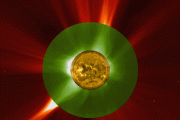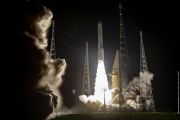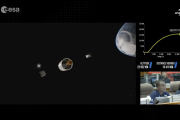
Copernical Team
Nearby Exoplanet Found with Hydrogen Sulfide Atmosphere
 A recent study by Johns Hopkins University, utilizing data from the James Webb Space Telescope, has uncovered that the atmosphere of the exoplanet HD 189733 b contains trace amounts of hydrogen sulfide, known for its rotten egg odor.
HD 189733 b, a gas giant similar in size to Jupiter, reveals new information about sulfur's role in planetary formation and atmospheric composition. The prese
A recent study by Johns Hopkins University, utilizing data from the James Webb Space Telescope, has uncovered that the atmosphere of the exoplanet HD 189733 b contains trace amounts of hydrogen sulfide, known for its rotten egg odor.
HD 189733 b, a gas giant similar in size to Jupiter, reveals new information about sulfur's role in planetary formation and atmospheric composition. The prese SpaceX Successfully Launches Turkey's First Home-Grown Communications Satellite
 SpaceX has launched a Falcon 9 rocket from Cape Canaveral Space Force Station on Monday night, carrying Turkey's first home-grown communications satellite.
The launch took place at 7:30 p.m. EDT after being delayed due to bad weather. The event was streamed online for viewers worldwide.
"All systems are looking good for today's launch of the @Turksat 6A mission from Florida. Weather
SpaceX has launched a Falcon 9 rocket from Cape Canaveral Space Force Station on Monday night, carrying Turkey's first home-grown communications satellite.
The launch took place at 7:30 p.m. EDT after being delayed due to bad weather. The event was streamed online for viewers worldwide.
"All systems are looking good for today's launch of the @Turksat 6A mission from Florida. Weather Subaru Telescope Discovers New Objects Beyond the Kuiper Belt
 The Subaru Telescope's comprehensive imaging has significantly contributed to the New Horizons mission, revealing potential extensions of the Kuiper Belt in the outer Solar System. By utilizing a unique analytical method on images captured by the telescope's ultra-wide-field camera, researchers have identified objects that might extend the known boundaries of the Kuiper Belt.
Beyond Neptun
The Subaru Telescope's comprehensive imaging has significantly contributed to the New Horizons mission, revealing potential extensions of the Kuiper Belt in the outer Solar System. By utilizing a unique analytical method on images captured by the telescope's ultra-wide-field camera, researchers have identified objects that might extend the known boundaries of the Kuiper Belt.
Beyond Neptun Martian Atmosphere Unveiled Through Innovative Use of Existing Technology
 An antenna on ExoMars' Trace Gas Orbiter has been repurposed to help researchers explore new areas of the Martian atmosphere.
Using this modified equipment, a team including researchers from Imperial College London has investigated previously unreachable regions of Mars' atmosphere. These areas, which can obstruct radio signals, are vital for future Mars habitation missions.
The anal
An antenna on ExoMars' Trace Gas Orbiter has been repurposed to help researchers explore new areas of the Martian atmosphere.
Using this modified equipment, a team including researchers from Imperial College London has investigated previously unreachable regions of Mars' atmosphere. These areas, which can obstruct radio signals, are vital for future Mars habitation missions.
The anal Orion and SLS Gearing Up for Major Artemis Missions
 NASA's Artemis program, aimed at returning humans to the Moon and beyond, is making significant strides with key developments in the Orion spacecraft and the Space Launch System (SLS) rocket. These advancements are vital as the space agency prepares for a series of increasingly ambitious missions to explore cislunar space and establish a sustainable human presence on the Moon.
b>Orion Spa
NASA's Artemis program, aimed at returning humans to the Moon and beyond, is making significant strides with key developments in the Orion spacecraft and the Space Launch System (SLS) rocket. These advancements are vital as the space agency prepares for a series of increasingly ambitious missions to explore cislunar space and establish a sustainable human presence on the Moon.
b>Orion Spa Artemis IV Set to Launch with Modernized RS-25 Engines
 Aerojet Rocketdyne, an L3Harris Technologies (NYSE:LHX) company, has successfully upgraded the four RS-25 engines that will propel NASA's Space Launch System (SLS) rocket for the Artemis IV mission. This mission will feature the first flight of the advanced Block 1B configuration of the SLS rocket and will be the last to use engines from the space shuttle era.
The upgraded Artemis IV engin
Aerojet Rocketdyne, an L3Harris Technologies (NYSE:LHX) company, has successfully upgraded the four RS-25 engines that will propel NASA's Space Launch System (SLS) rocket for the Artemis IV mission. This mission will feature the first flight of the advanced Block 1B configuration of the SLS rocket and will be the last to use engines from the space shuttle era.
The upgraded Artemis IV engin Germany's Integral Role in the Ariane 6 Launch Program
 The Ariane 6, Europe's new launcher, is set for its maiden voyage on 9 July 2024. This rocket aims to provide Europe with reliable and cost-effective access to space, succeeding the Ariane 5 while offering greater flexibility. Germany stands as the second-largest contributor to the European Space Agency's (ESA) Ariane 6 program, with the German Space Agency at the German Aerospace Center (DLR) i
The Ariane 6, Europe's new launcher, is set for its maiden voyage on 9 July 2024. This rocket aims to provide Europe with reliable and cost-effective access to space, succeeding the Ariane 5 while offering greater flexibility. Germany stands as the second-largest contributor to the European Space Agency's (ESA) Ariane 6 program, with the German Space Agency at the German Aerospace Center (DLR) i CubeSat propulsion technologies are taking off
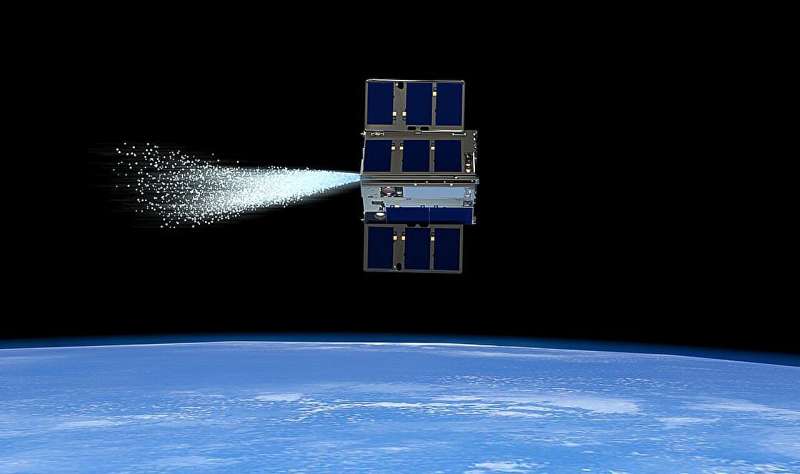
CubeSats are becoming ever more popular, with about 2,400 total launched so far. However, the small size limits their options for fundamental space exploration technologies, including propulsion. They become even more critical when mission planners design missions that require them to travel to other planets or even asteroids.
A team from Khalifa University of Science and Technology in Abu Dhabi recently released a review in Aerospace of the different CubeSat propulsion technologies currently available—let's look at their advantages and disadvantages.
The paper breaks propulsion systems into four categories: Chemical, Kinetic, Electrical, and "Propellant-less." Chemical systems are the traditional rockets most people think of when launching satellites—they burn chemicals together and expel gas created by the fire to produce thrust. Kinetic systems use things like cold gas, where instead of reacting two chemicals together, they simply push gas molecules out to propel themselves in the opposite direction.
Swarms of orbiting sensors could map an asteroid's surface
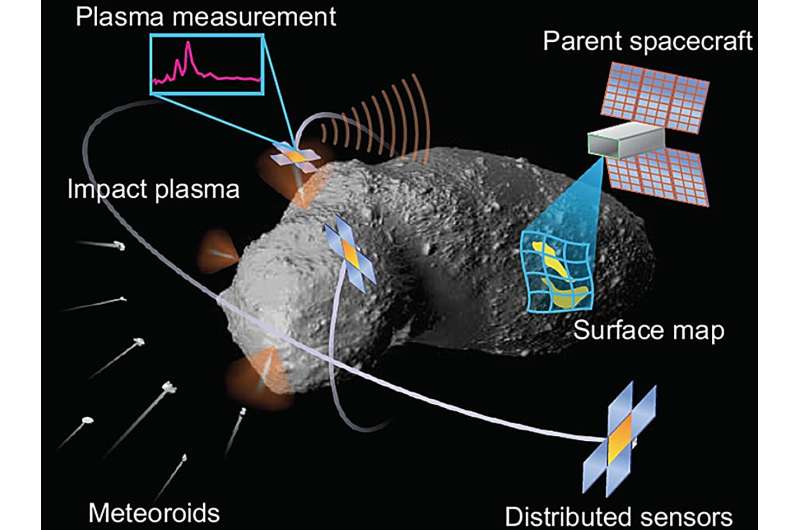
It seems like every month a new story appears announcing the discovery of thousands of new asteroids. Tracking these small body objects from ground and even space-based telescopes helps follow their overall trajectory. But understanding what they're made of is much more difficult using such "remote sensing" techniques.
To do so, plenty of projects get more up close and personal with the asteroid itself, including one from Dr. Sigrid Elschot and her colleagues from Stanford, which was supported by NASA's Institute for Advanced Concepts back in 2018. It uses an advanced suite of plasma sensors to detect an asteroid's surface composition by utilizing a unique phenomenon—meteoroid impacts.
The project, known as the Meteroid Impact Detection for Exploration of Asteroids (MIDEA), has an architecture that has become more prominent as of late—a swarm of smallsats coordinated around a mothership. In this case, the smallsats are plasma sensors with one specific purpose: to detect characteristics of the plume of debris from the asteroid after a meteoroid hits it.
A handy attachment could make lunar construction a breeze
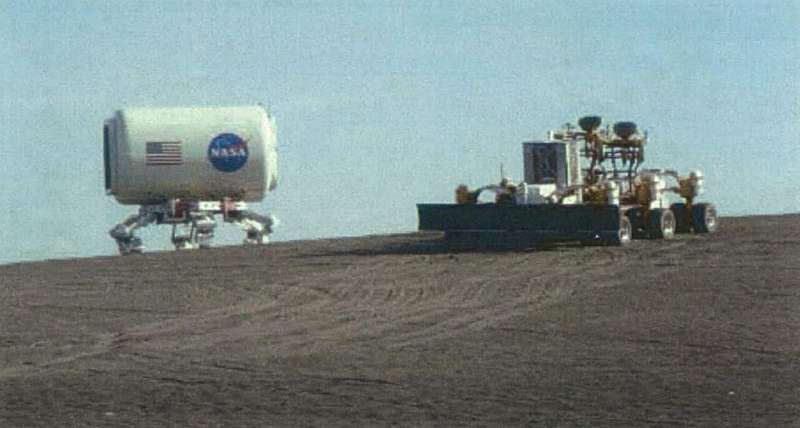
Moving large amounts of regolith is a requirement for any long-term mission to the moon or Mars. But so far, humanity has only sent systems capable of moving small amounts of soil at a time—primarily for sample collection. Sending a large, dedicated excavator to perform such work might be cost-prohibitive due to its weight, so why not send a bulldozer attachment to a mobility unit already planned for use on the surface?
That was the thought process of an interdisciplinary team of engineers from NASA and the Colorado School of Mines. They came up with the Lunar Attachment Node for Construction and Excavation—or LANCE.
LANCE is an attachment to NASA's Chariot rover prototype, which was originally designed to be the primary mobility system for astronauts returning to the moon. However, it was designed in 2007, when the original NASA Lunar Architecture plan was to establish a permanent lunar base in 2019.




























